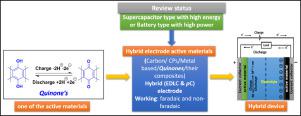Journal of Energy Storage ( IF 8.9 ) Pub Date : 2021-12-02 , DOI: 10.1016/j.est.2021.103700 Sai Prasad Ega 1, 2 , Palaniappan Srinivasan 1, 2

|
Supercapacitor, an energy storage device, has received much attention in recent years. The construction of supercapacitor devices with a suitable anode, cathode, and electrolyte materials plays a vital role in commercialization. In this direction, quinones are being used as electroactive materials in the last two decades. Carbon-quinones are considered to be the most promising materials and capable of increasing the performance of electrochemical capacitors. This review provides a clear idea about the classification of supercapacitors based on the use of electrodes, electrolytes, and their mechanisms, device configurations. The performances of the supercapacitors with carbon-quinone composites used as electrodes in the literature are reviewed. The effect of the incorporation of quinones with various carbon materials via physical adsorption, impregnation, grafting, solvent-free, solvothermal, wet chemistry, hydrothermal, and reflux methods in the overall performance of supercapacitors are discussed. In summary, the advantages of the use of quinones in a supercapacitor, the drawbacks associated with these materials, and future directions towards commercialization are brought out.
中文翻译:

超级电容器醌材料:现状、方法和未来方向
超级电容器作为一种储能装置,近年来备受关注。具有合适的阳极、阴极和电解质材料的超级电容器装置的构建在商业化中起着至关重要的作用。在这个方向上,在过去的二十年里,醌被用作电活性材料。碳醌被认为是最有前途的材料,能够提高电化学电容器的性能。这篇综述提供了关于基于电极、电解质及其机制、设备配置的超级电容器分类的清晰思路。综述了文献中采用碳-醌复合材料作为电极的超级电容器的性能。通过物理吸附将醌与各种碳材料结合的效果,讨论了超级电容器整体性能中的浸渍、接枝、无溶剂、溶剂热、湿化学、水热和回流方法。总之,提出了在超级电容器中使用醌的优点、与这些材料相关的缺点以及未来商业化的方向。















































 京公网安备 11010802027423号
京公网安备 11010802027423号